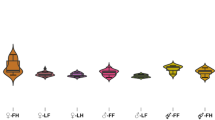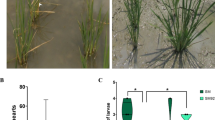Abstract
As the sole plant source of many potent alkaloids, opium poppy (Papaver somniferum L.) is an important medicinal crop. Nevertheless, few studies have characterized opium poppy germplasm with crop-specific molecular markers. Because Turkey is a diversity center for opium poppy, Turkish germplasm is a valuable genetic resource for association mapping studies aimed at identifying QTLs controlling morphine content and agronomic traits. In this study, the morphological diversity and molecular diversity of 103 Turkish opium poppy landraces and 15 cultivars were analyzed. Potentially useful morphological variation was observed for morphine content, plant height, and capsule index. However, the landraces exhibited limited breeding potential for stigma number, and seed and straw yields. Both morphological and molecular analyses showed distinct clustering of cultivars and landraces. In addition, a total of 164 SSR and 367 AFLP polymorphic loci were applied to an opium poppy association mapping panel composed of 95 opium poppy landraces which were grown for two seasons. One SSR and three AFLP loci were found to be significantly associated with morphine content (P < 0.01 and LD value (r 2) = 0.10–0.32), and six SSR and 14 AFLP loci were significantly associated with five agronomic traits (plant height, stigma number, capsule index, and seed and straw yields) (P < 0.01 and LD value (r 2) = 0.08–0.35). This is the first report of association mapping in this crop. The identified markers provide initial information for marker-assisted selection of important traits in opium poppy breeding.


Similar content being viewed by others
References
Abdurakhmonov IY, Kohel RJ, Yu JZ, Pepper AE, Abdullaev AA, Kushanov FN, Abdukarimov A (2008) Molecular diversity and association mapping of fiber quality traits in exotic G. hirsutum L. germplasm. Genomics 92(6):478–487. doi:10.1016/j.ygeno.2008.07.013
Acharya HS, Sharma V (2009) Molecular characterization of opium poppy (Papaver somniferum) germplasm. Am J Infect Dis 5:148–153
Achleitner A, Tinker NA, Zechner E, Buerstmayr H (2008) Genetic diversity among oat varieties of worldwide origin and associations of AFLP markers with quantitative traits. Theor Appl Genet 117(7):1041–1053. doi:10.1007/s00122-008-0843-y
Akhatar J, Banga SS (2015) Genome-wide association mapping for grain yield components and root traits in Brassica juncea (L.) Czern & Coss. Mol Breed 35:48. doi:10.1007/s11032-015-0230-8
Arslan N, Buyukgocmen R, Gumuscu A (2000) Türk haşhaş populasyonlarının yağ ve morfin muhtevaları. J Field Crops Central Res Inst 9:1–2
Bhandari MM (1990) Out-crossing in opium poppy Papaver somniferum L. Euphytica 48:167–169. doi:10.1007/BF00037196
Bradbury PJ, Zhang Z, Kroon DE, Casstevens TM, Ramdoss Y, Buckler ES (2007) TASSEL: software for association mapping of complex traits in diverse samples. Bioinformatics 23(19):2633–2635. doi:10.1093/bioinformatics/btm308
Brezinová B, Macák M, Eftimová J (2009) The morphological diversity of selected traits of world collection of poppy genotypes (genus Papaver). J Cent Eur Agric 10:183–192
Celik I, Gultekin V, Allmer J, Doganlar S, Frary A (2014) Development of genomic simple sequence repeat markers in opium poppy by next-generation sequencing. Mol Breed 34:323–334. doi:10.1007/s11032-014-0036-0
Collard BCY, Jahufer MZZ, Brouwer JB, Pang ECK (2005) An introduction to markers, quantitative trait loci (QTL) mapping and marker-assisted selection for crop improvement: the basic concepts. Euphytica 142:169–196. doi:10.1007/s10681-005-1681-5
Dent AE, Bridgett MV (2012) Structure harvester: a website and program for visualizing STRUCTURE output and implementing the Evanno method. Conserv Genet Resour 4:359–361. doi:10.1007/s12686-011-9548-7
Dittbrenner A, Lohwasser U, Mock HP, Borner A (2008) Molecular and phytochemical studies of Papaver somniferum in the context of infraspecific classification. Acta Hortic 799:81–88. doi:10.17660/ActaHortic.799.9
Doyle JJ, Doyle JE (1990) Isolation of plant DNA from fresh tissue. Focus 12:13–15
Eckert AJ, Wegrzyn JL, Cumbie WP, Goldfarb B, Huber DA, Tolstikov V, Fiehn O, Neale DB (2012) Association genetics of the loblolly pine (Pinus taeda, Pinaceae) metabolome. New Phytol 193:890–902
Facchini PJ, De Luca V (2008) Opium poppy and Madagascar periwinkle: model non-model systems to investigate alkaloid biosynthesis in plants. Plant J Cell Mol Biol 54:763–784. doi:10.1111/j.1365-313X.2008.03438.x
Gómez G, Álvarez MF, Mosquera T (2011) Association mapping, a method to detect quantitative trait loci: statistical bases. Agronomía Colombiana 29(3):367–376
Gumuscu A, Arslan N (1999) Comparing yield and yield components of some selected poppy (Papaver somniferum L.) lines. Turk J Agric For 4:991–997
Gumuscu A, Arslan N (2008) Researches on heterosis on yield and yield components of some poppy hybrid lines. J Agric Sci 14:365–373
Gumuscu A, Arslan N, Sarıhan EO (2008) Evaluation of selected poppy (Papaver somniferum L.) lines by their morphine and other alkaloids contents. Eur Food Res Technol 226:1213–1220. doi:10.1007/s00217-007-0739-0
Jones N, Ougham H, Thomas H, Pašakinskienė I (2009) Markers and mapping revisited: finding your gene. New Phytol 183(4):935–966. doi:10.1111/j.1469-8137.2009.02933.x
Norusis MJ (2010) PASW statistics 18 advanced statistical procedures. Prentice Hall Press, Englewood Cliffs
Parmaksiz I, Ozcan S (2011) Morphological, chemical and molecular analyses of Turkish Papaver accessions (Sect. Oxytona). Turk J Bot 35:1–16. doi:10.3906/bot-1003-39
Patra NK, Ram RS, Chauhan SP, Singh AK (1992) Quantitative studies on the mating system of opium poppy (Papaver somniferum L.). Theor Appl Genet 84:299–302. doi:10.1007/BF00229486
Perrier X, Jacquemoud-Collet JP (2006) DARwin software. http://darwin.cirad.fr/darwin
Prajapati S, Bajpai S, Singh D, Luthra R, Gupta MM, Kumar S (2002) Alkaloid profiles of the Indian land races of the opium poppy Papaver somniferum L. Genet Resour Crop Evol 49:183–188. doi:10.1023/A:1014763412736
Price AL, Patterson NJ, Plenge RM, Weinblatt ME, Shadick NA, Reich D (2006) Principal components analysis corrects for stratification in genome-wide association studies. Nat Genet 38:904–909. doi:10.1038/ng1847
Pritchard JK, Stephens M, Donnelly P (2000a) Inference of population structure using multilocus genotype data. Genetics 155:945–959
Pritchard JK, Stephens M, Rosenberg NA, Donnelly P (2000b) Association mapping in structured populations. Am J Hum Genet 67:170–181. doi:10.1086/302959
Qin H, Chen M, Yi X, Bie S, Zhang C, Zhang Y, Lan J, Meng Y, Yuan Y, Jiao C (2015) Identification of associated SSR markers for yield component and fiber quality traits based on frame map and upland cotton collections. PloS ONE 10(1). doi:10.1371/journal.pone.0118073
Ranc N, Muños S, Xu J, Le Paslier MC, Chauveau A, Bounon R, Rolland S, Bouchet JP, Brunel D, Causse M (2012) Genome-wide association mapping in tomato (Solanum lycopersicum) is possible using genome admixture of Solanum lycopersicum var. cerasiforme. G3 Genes Genom Genet 2(8):853–864. doi:10.1534/g3.112.002667
Saunders JA, Pedroni MJ, Penrose LDJ, Fist AJ (2001) AFLP analysis of opium poppy. Crop Sci 41:1596–1601. doi:10.2135/cropsci2001.4151596x
Selale H, Celik I, Gultekin V, Allmer J, Doganlar S, Frary A (2013) Development of EST-SSR markers for diversity and breeding studies in opium poppy (Papaver somniferum L.). Plant Breed 132:344–351. doi:10.1111/pbr.12059
Semagn K, Bjørnstad Å, Xu Y (2010) The genetic dissection of quantitative traits in crops. Electron J Biotechn 13(5):16–17. doi:10.2225/vol13-issue5-fulltext
Shukla S, Yadav HK, Rastogi A, Mishra BK, Sant Singh P (2010) Alkaloid diversity in relation to breeding for specific alkaloids in opium poppy (Papaver somniferum L.). Czech J Genet Plant Breed 46:164–169
Singh SP, Shukla S, Yadav HK (2004) Genetic studies and their implication to breed desired plant type in opium poppy, Papaver somniferum L. Genetika 36:69–81. doi:10.2298/GENSR0401069S
Stich B, Melchinger AE, Frisch M, Maurer HP, Heckenberger M, Reif JC (2005) Linkage disequilibrium in European elite maize germplasm investigated with SSRs. Theor Appl Genet 111(4):723–730. doi:10.1007/s00122-005-2057-x
Storey JD (2002) A direct approach to false discovery rates. J R Stat Soc Ser B 64:479–498. doi:10.1111/1467-9868.00346
Storey JD, Tibshirani R (2003) statistical significance for genome-wide experiments. Proc Natl Acad Sci USA 100:9440–9445. doi:10.1073/pnas.1530509100
Tétényi P (1997) Opium poppy (Papaver somniferum) botany and horticulture. Hortic Rev 19:373–408. doi:10.1002/9780470650622.ch7
Trivedi M, Tiwari RK, Dhawan OP (2006) Genetic parameters and correlations of collar rot resistance with important biochemical and yield traits in opium poppy (Papaver somniferum L.). J Appl Genet 47:29–38. doi:10.1007/BF03194596
Turkish Soil Product Office (2009) Opium poppy report. Turkish Soil Production Office, Ankara
Turkish Soil Product Office (2014) Opium poppy report. Turkish Soil Production Office, Ankara
Wang ML, Sukumaran S, Barkley NA, Chen Z, Chen CY, Guo B, Pittman RN, Stalker HT, Holbrook CC, Pederson GA, Yu J (2011) Population structure and marker–trait association analysis of the US peanut (Arachis hypogaea L.) mini-core collection. Theor Appl Genet 123(8):1307–1317. doi:10.1007/s00122-011-1668-7
Weber AL, Briggs WH, Rucker J, Baltazar BM, Sánchez-Gonzalez JDJ, Feng P, Bucler ES, Doebley J (2008) The genetic architecture of complex traits in teosinte (Zea mays ssp. parviglumis): new evidence from association mapping. Genetics 180(2):1221–1232. doi:10.1534/genetics.108.090134
Wei W, Zhang Y, Lü H, Li D, Wang L, Zhang X (2013) Association analysis for quality traits in a diverse panel of Chinese sesame (Sesamum indicum L.) germplasm. J Integr Plant Biol 55(8):745–758. doi:10.1111/jipb.12049
Yadav HK, Shukla S, Singh SP (2006) Genetic variability and interrelationship among opium and its alkaloids in opium poppy (Papaver somniferum L.). Euphytica 150:207–214. doi:10.1007/s10681-006-9111-x
Yu J, Pressoir G, Briggs WH, Bi IV, Yamasaki M, Doebley JF, McMullen MD, Gaut BS, Holland JB, Kresovich S, Buckler ES (2006) A unified mixed-model method for association mapping accounting for multiple levels of relatedness. Nat Genet 38:203–208. doi:10.1038/ng1702
Zhu C, Gore M, Buckler ES, Yu J (2008) Status and prospects of association mapping in plants. Plant Genome 1(1):5–20. doi:10.3835/plantgenome2008.02.0089
Acknowledgments
This study was supported by The Scientific and Technological Research Council of Turkey (TUBITAK) Project No: 109O797. We thank Amy Frary for review of the manuscript.
Author contributions
IC performed molecular characterization, data analysis, and manuscript preparation. HC, AK, and FCK performed morphological characterization. SD involved in experimental design and manuscript preparation. AF performed data analysis and manuscript preparation.
Author information
Authors and Affiliations
Corresponding author
Ethics declarations
Conflict of interest
The authors declare that they have no conflict of interest.
Electronic supplementary material
Below is the link to the electronic supplementary material.
Rights and permissions
About this article
Cite this article
Celik, I., Camci, H., Kose, A. et al. Molecular genetic diversity and association mapping of morphine content and agronomic traits in Turkish opium poppy (Papaver somniferum) germplasm. Mol Breeding 36, 46 (2016). https://doi.org/10.1007/s11032-016-0469-8
Received:
Accepted:
Published:
DOI: https://doi.org/10.1007/s11032-016-0469-8




